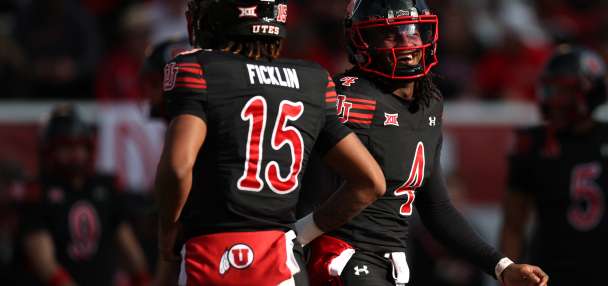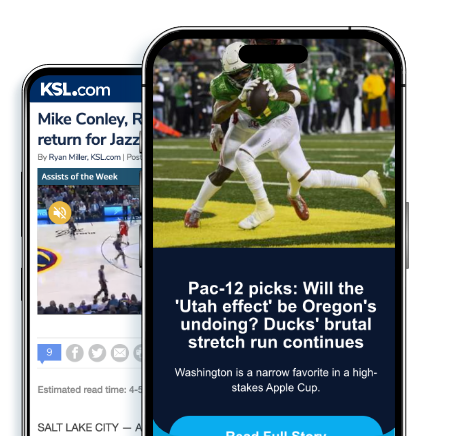Estimated read time: 5-6 minutes
- Devon Dampier, Utah's new quarterback, faces challenges transitioning to Power Four play.
- His past performance against top teams shows potential for success in the Big 12.
- Utah's strong offensive lineup and familiar coaching staff may aid Dampier's adaptation.
SALT LAKE CITY — As Devon Dampier prepares for his first season as Utah's starting quarterback, the biggest question facing the dual-threat talent is whether he can have similar success in a Power Four conference.
That question won't start to be answered until Utah kicks off the season officially on Aug. 30 on the road against UCLA. But a look back at Dampier's performances against "power" competition last season can give a hint at what type of player he can be.
No doubt, the weekly rigors of a power conference schedule will be more demanding, but the talent around him has also improved, especially with the veteran unit up front.
Entering the season, Dampier already stacks up as one of the best quarterbacks in the Big 12, according to his offensive grade (89.9) by Pro Football Focus. Only Arizona State's Sam Leavitt (90.1) is better among the retuning quarterbacks.
But can Dampier be one of the best in the Big 12 this season with equal competition?
To start, let's take a look at his stats while at New Mexico last season. Dampier led the Lobos to the fourth-best offense (484.3 yards per game) in the country, while amassing 2,768 yards, 12 touchdowns and 12 interceptions on a needs-improvement 57.9% completion percentage.
He added an additional 1,166 yards and 19 touchdowns as the team's leading rusher.
Among those season stats, Dampier totaled 725 passing yards, five touchdowns and four interceptions against P4 competition (at Arizona, at Auburn, vs. Washington State). He added 354 rushing yards, five touchdowns, and three fumbles in those games.
But now let's add some context ...
His offensive line, which ranked inside the top 25 for the season in pass and run blocking, was mediocre against the aforementioned three opponents. Against the Wildcats, the offensive line graded out to a 55.2 in pass blocking and 54.9 in run blocking, according to PFF.
By PFF's grading scale, that's just slightly between "below average" and "average" — so not great.
For that game, Dampier threw for 260 yards and three touchdowns (and two interceptions) on 57.1% passing. He got an adjusted 69.2% completion percentage based on dropped passes and situations out of his control, according to PFF.
He also added 130 yards (8.7 yards per carry) and two touchdowns on the ground, totaling five touchdowns he contributed in the game.
The offensive line was better a week later against Auburn, grading out to a 66.0 in pass blocking and a 61.0 in run blocking, but the performance was just above "average" and edging toward "above average."
Dampier threw for 291 yards, one touchdown and two interceptions on 48.9% passing, but his receivers had an incredibly high drop rate (15.4%) so his adjusted passing completion jumped up to 65.0%, according to PFF.
He only added 31 rushing yards in the game, but averaged 6.2 yards per carry against an Auburn run defense that finished 27th in the country.
His last competition came late in the season against Washington State, which was a school on the bubble as a "power" program following the Pac-12 collapse. Against the Cougars, the offensive line had an improved 70.4 grade ("above average") in pass blocking, but a 52.6 grade ("below average") in run blocking.
Dampier, though, threw for 174 yards and one touchdown on an adjusted 50% completion percentage — not great — but he more than made up for it with his 193 rushing yards (6.9 avg.) and three touchdowns en route to a 38-35 victory at home.
In all three games, he took on a combined 32 pressures from the defense and wasn't sacked once. Dampier was only sacked four times — or 4.1% of all pressures turned into sacks — last season, which is the least of all returning Big 12 quarterbacks.
The next closest was Kansas State's Avery Johnson (8.3% of all pressures) and Kansas' Jalon Daniels (10.1%).
Additionally, in those three games, Dampier only managed two "turnover worthy plays," according to PFF, and one batted-down pass. For the season, Dampier only had 10 turnover worthy plays — or 2.1% of his passes — and two batted-down passes.
He did that while maintaining one of the best average depth's of target, or aDoT, at 11.9 yards. Only Daniels (12.4) and Colorado transfer QB Kaidon Salter (11.9) had a better or equal aDoT.
Dampier also managed the second-most "big-time throws" of 20 on the season, which is a "pass with excellent ball location and timing, generally thrown further down the field and/or into a tighter window," according to PFF. Only Daniels (22 passes) had more, with Texas Tech's Behren Morton also finishing with 20.
There are no guarantees that Dampier can transition to a Power Four schedule with the same efficacy, but the sample size from last season shows promise. He also gets his same play-caller in Jason Beck to join him at Utah, adding to his ability to acclimate with some familiarity.
While Dampier will factor in significantly to Utah's offense, the coaching staff brought in several players to lighten his load in all facets of the game, including a sort of "Swiss Army Knife" role for fellow quarterback/athlete Nate Johnson.
Add to that an offensive line that features two projected first round picks (Spencer Fano and Caleb Lomu) in next year's NFL draft and a workhorse back in Wayshawn Parker, and Dampier will likely have the best talent he's ever had around him.
None of that is a guarantee, but the optics are looking in his favor for a similar type of season at Utah.








